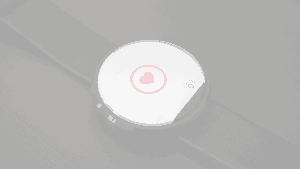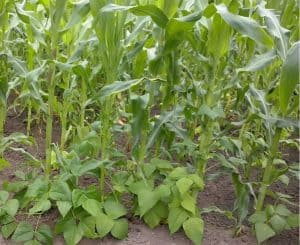Do you know that the infancy is a critical time during which we develop most of our defense mechanisms in the gut? Recently, we have discovered something else: during this period of time, the MUC17-based glycocalyx, one of the major protective barriers in the intestine, is developed!
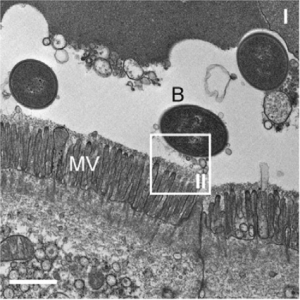
The intestine is home to trillions of microorganisms, collectively named microbiota, that tend to benefit our body. To “control” this neighborhood, we possess a complex gut barrier that consists of mucus layers that can trap bacteria and the intestinal glycocalyx, which creates a barrier over the cells in the intestine that keeps the bugs far away from direct contact with us (see Fig.1). Then, if some of these protective walls are broken, the risk of bacteria encountering the cells in the intestine is higher, which subsequently leads to more chances of contracting inflammatory diseases such as Crohn’s disease or ulcerative colitis if these bacteria are not beneficial to us.
Our study, led by the University of Gothenburg and conducted in neonatal mice at mucin biology groups laboratories, shows that the membrane protein mucin MUC17 is the major component of the intestinal glycocalyx, which protects the intestine against bacteria (see Fig. 2). Surprisingly, we found that the intestinal glycocalyx is established during the infancy and protects us against bacteria and harmful molecules in the adulthood (see Fig. 3). Specifically, we found that the interleukin 22 (Il-22), which is involved in most of the immunity development mechanisms in the intestine during early life, promotes the expression of this Muc17-based glycocalyx!
Interestingly, after birth is a critical period where environmental factors, including the gut microbiota, “train” the immune system to develop strong intestinal defenses. We found that the Il-22 produced by immune cells promotes the expression of the protective Muc17-based glycocalyx barrier at the time of weaning. Specifically, interleukins are important cytokines that are involved in many biological processes that range from inflammation to defense mechanisms. In this case, Il-22 is a protective cytokine that, not only promotes the expression of the Muc17-based glycocalyx, but also other studies have shown that it triggers the production of antimicrobial components to control the community of bugs in our gut.
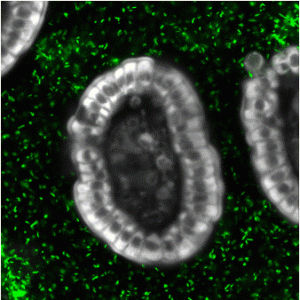
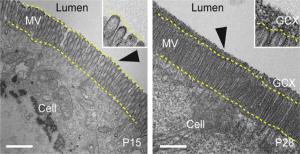
If this normal microbiota is disrupted at infancy, the development of the glycocalyx could be altered and, consequently, the intestinal defenses in the protection against pathogenic bacteria in adulthood too. Nevertheless, if this occurred, there is a way that could possibly fix this: we could reinforce this barrier with dietary interventions during early life, a completely new research field yet to be widely explored! Now, we will focus on finding these new factors that could stimulate or disturb the development of the glycocalyx and its protective role in the intestines. We believe that our findings will be important in the future to understand the pathogenesis of inflammatory diseases at the gut.
* * *
By Elena Layunta Hernández (@ELayunta), international post-doctoral researcher at the Mucin Biology Groups at the University of Gothenburg (Sweden).
***
The study this post is based on, entitled “IL-22 promotes the formation of a MUC17 glycocalyx barrier in the postnatal small intestine during weaning”, was published in the scientific journal Cell Reports the 16th of February in 2021. The authors are Elena Layunta, Sofia Jäverfelt, Brendan Dolan, Liisa Arike, and Thaher Pelaseyed. You can read it here.
The project was supported by eight different associations including Swedish Society for Medical Research (SSMF), National Institutes of Health/Mucosal Immunology Studies Team (NIH/MIST), and the Wenner-Gren Foundations.
***
More information:


